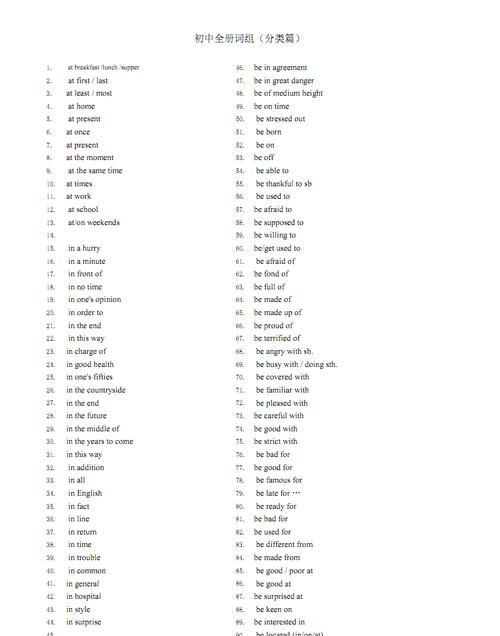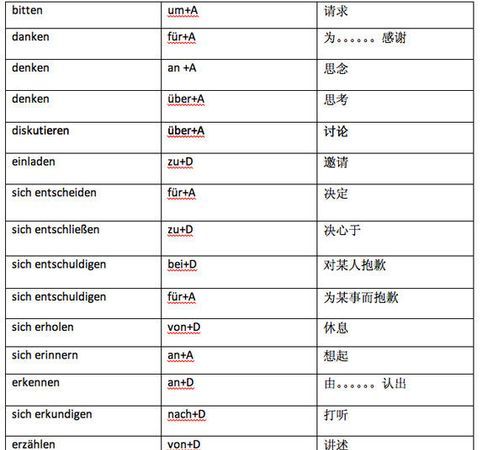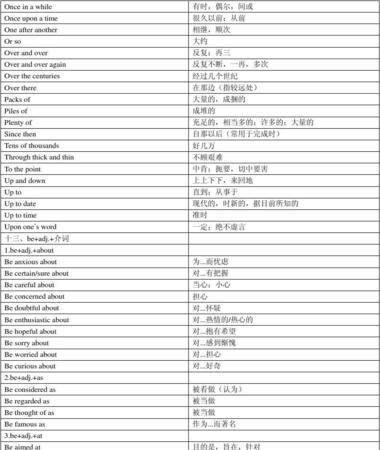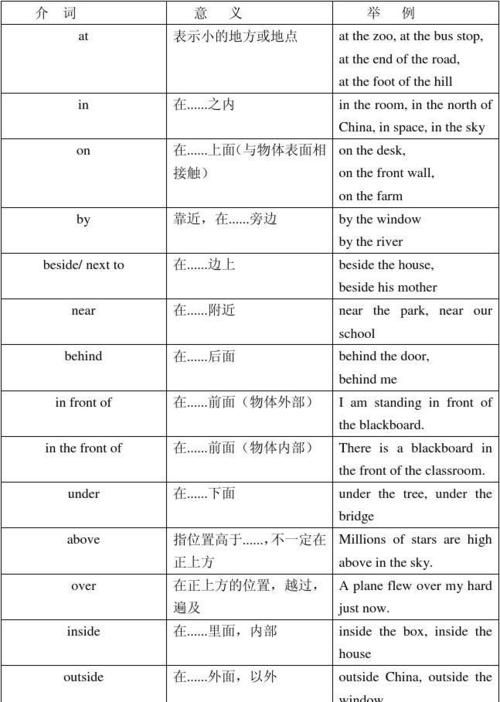说起初中英语中的介词都有哪些 想必大家都想知道。今天就给家解读一下。谁能告诉我初中英语中所有介词?和初中的英语中常用的介词有哪些?初中英语中的介词都有哪些 的内容,方便您深入了解初中英语有哪些常见介词,接下来一起看看。
初中英语中的介词都有哪些 :谁能告诉我初中英语中所有介词
介词
1)at
,in,
on,
to
at
(1)表示在小地方;
(2)表示“在……附近,旁边”
in
(1)表示
在大地方;
(2)表示“在…范围之内”。
on
表示毗邻,接壤,“在……上面”。
to
表示在……范围外,不强调是否接壤;或“到……”
2)above,
over,
on
在……上
above
指在……上方,不强调是否垂直,与
below相对;
over指垂直的上方,与under相对,但over与物体有一定的空间,不直接接触。
on表示某物体上面并与之接触。
3)below,
under
在……下面
under表示在…正下方
below表示在……下,不一定在正下方
1)in
,
on,at
在……时
in表示较长时间,如世纪、朝代、时代、年、季节、月及一般(非特指)的早、中、晚等。
on表示具体某一天及其早、中、晚。
at表示某一时刻或较短暂的时间,或泛指圣诞节,复活节等。
注意:在last,
next,
this,
that,
some,
every
等词之前一律不用介词。 2)in,
after
在……之后
“in
+段时间”表示将来的一段时间以后;
“after+段时间”表示过去的一段时间以后;
“after+将来点时间”表示将来的某一时刻以后。
3)from,
since
自从……
from仅说明什么时候开始,不说明某动作或情况持续多久;
since表示某动作或情况持续至说话时刻,通常与完成时连用。
4)after,
behind
在……之后
after主要用于表示时间;
behind主要用于表示位置。
across,
through
通过,穿过
across表示横过,即从物体表面通过,与on有关;
through穿过,即从物体内部穿过,与in有关。
between,
among
between指在两个人或两个事物之间;
among指在三个或三个以上的人或事物之间。
1)on
,about
关于
on
表示这本书,这篇文章或演说是严肃的,或学术性的,可供专门研究这一问题的人阅读;
about表示内容较为普通,不那么正式。
2)by,
with,
in
表示方法、手段、工具
by
以……方法、手段或泛指某种交通工具;
with
表示用
…工具、手段,一般接具体的工具和手段;
in
表示用…方式,用…语言(语调、笔墨、颜色)等;
3)except,
besides
除了
except
除……之外,不包括在内;
besides
除……之外,包括在内。

初中英语中的介词都有哪些 :初中英语有哪些常见介词
表方位的有:at
,in,
on,
to(大多数情况是做不定式后街动词原形,作介词时,意思是到……地方去),for,above,
over,
on,below,
under,
in
front
of,
in
the
front
of,beside,behind
表示时间的有:in
,
on,at,
in,
after
,from,
since,
after,
behind
表示运动方向的across,
through
表示“在……之间”的between两者,
among三者或三者以上
表示其他意义的on
,about
关于
by,
with,
in
表示方法、手段、工具
except不包括,
besides(包括)
除了
介词后面跟动词时一定跟ing形式,介词后面也可以加名词或从句

初中英语中的介词都有哪些 :初中的英语中常用的介词有哪些
一、介词按其构成可分为: 1. 简单介词 at, in, on, to, since, until等。如: He's worked there since 1998. 2. 复合介词 into, onto, out of等。如: She is out of school. 她毕业了。 3. 二重介词 from under, from behind, from out of, until after, except in等。如: I'm from out of town. 我是从城外来的。 4. 短语介词 because of, instead of, in spite of等。如: I went back not because of the rain, but because I was tired.我回去不是因为下雨,而是因为我累了。 二、介词的作用: 1. 表示地点: after, along, at, below, by, of, near, over, through, under等。如: Near the village the boys are skating on the ice. 男孩子们正在村子附近的冰上滑冰。 They lay down under the shade of a tree. 他们躺在一棵树的树阴下。 2. 表示时间: about, after, across, at, during, for, in, of, till, until等。如: After class he will tell us about the accident. 课后他将告诉我们有关事故的情况。 A heavy rain has been falling across three days. 一场大雨下了整整三天。 The accident happened during the night. 事故发生在夜间。 3. 表示动作: at, across, around, on, over, under等。如: The earth goes around the sun. 地球绕太阳运行。 The car is under repair. 汽车在修理中。 4. 表示比较: as, like, above, over, with等。如: She was something like her sister. 她有几份像她的妹妹。 Chinese is much more difficult in contrast with English. 和英语相比,汉语难得多。 5. 表示原因: about, for, from, with等。如: Don't worry about my lessons. 不要担心我的功课。 Business kept me from coming. 我因事不能来。 He was angry with what I did. 他对我所做的很气愤。 6. 表示条件: to, with, without等。如: Without your advice, he would have failed. 没有你的忠告他可能已经失败了。 7. 表示手段、方式: as, by, in, with等。如: He behaved as a drunkard. 他的举止如同醉汉一样。 Learn the new words by heart.记住这些生词。 We see with our eyes.我们用眼睛看。 8. 表示距离、数量: from, in, within等。如: My house is ten miles from the school. 我家离学校十英里。 They were thirty in all. 他们总共有三十人。 9. 表示目的: as, for等。如: I only said it as a joke. 我只是把它当作笑话讲的。 It's time for class. 到上课的时间了。 10. 表示让步: for, with等。如: For all his effort, he didn't succeed. 虽然他做了一番努力,仍不能成功。 With all his money, he is unhappy. 尽管他有钱,但他并不快乐。 for还可以引导插入语,例如: I, for one, shall vote against the proposal. 我也投票反对这个提议以上希望对你有帮助,是几乎所有介词的用法了 by的用法(1)表示在……旁,如by the fire 在炉火旁。(2)用于被动语态,表示“被”,如It is planted by Tom . (3)到……为止,在……以前,如We can get the books by Monday . (4)依照,依据,如By your theory , ……,按你的理论,……(5)表示方法,手段,by sea乘船,by bus(6)由于,因……,I”d know you by your laugh . (7)表示把,握的部位,She pulled me by the sleeve . 她抓住我的衣袖。in的用法:in是介词,介词后面必须接名词,代词或者动名词,即doing。 这是介词的一个特点,当介词in单独使用时,或者与其它动词构成固定搭配时,都不能脱离其作为介词的特点。in 常用意思:在..., 在...之内,从事于..., 按照..., 穿着...。 He was born in 1992. 他生于1992年。 I could finish the program in two weeks.我可以用两周时间完成这个项目。 He spend less time in reading.他读书时间很少。 The man in black jacket is our teacher.穿黑夹克的那个人是我们的老师。in是介词,介词后面必须接名词,代词或者动名词,即doing。 这是介词的一个特点,当介词in单独使用时,或者与其它动词构成固定搭配时,都不能脱离其作为介词的特点。in 常用意思:在..., 在...之内,从事于..., 按照..., 穿着...。 He was born in 1992. 他生于1992年。 I could finish the program in two weeks.我可以用两周时间完成这个项目。 He spend less time in reading.他读书时间很少。 The man in black jacket is our teacher.穿黑夹克的那个人是我们的老师。 一些与介词in的固定搭配 表示时间in 1999, in 20 century,表示地点in a car, in a queue, 表示状态in charge(看管), in church, in class,to的用法一:表示相对,针对 be strange (common, new, familiar) to二:表示对比,比较1:以-ior结尾的形容词,后接介词to表示比较,如:superior ,inferior,prior,senior,junior The quarrel happened prior to my arrival. 2:一些本身就含有比较或比拟意思的形容词,如equal,similar,equivalent,analogous A is similar to B in many ways. 3:表示一些先后顺序的形容词,如:second,subsequent,next,preliminary,preparatory 4:to也偶尔出现在个别动词之后,与动词形成固定词组,表示比较,如:prefer to,compare to,in contrast to compare to sth.表示比喻或比拟,而compare with sth.表示比较,如: World is usually compared to a stage

初中英语中的介词都有哪些 :初中英语中常用的介词有哪些
1)简单介词:about, across, after, against, among, around, at, before, behind, below, beside, but, by, down, during, for, from, in, of, on, over, near, round, since, to, under, up, with等等。
2)合成介词:inside, into, outside, throughout, upon, without, within
3)短语介词:according to, along with, apart from, because of, in front of, in spite of, instead of, owing to, up to, with reguard to
4)分词介词:considering, reguarding, including, concerning
2.从意思上考虑,介词可分为下面三类:
1)引导时间短语的介词:
at, on, in, during, before, after, over, from, following, by, till, until, towards, for, throughout, upon, since, pending, all through, prior to
2) 引导地点状语的介词:
in, at, across, to, down, under, near, between, over, from, into, through, onto, off, outside, out of, inside, within, beside, behind, below, among, beyond, against, around, before, up, ahead of, via, in front of, under, along, past, opposite, above, next to
3) 引导其他短语的介词:
by, with, about, except, like, of, according to, instead of, without, in, due to, because of, along with, as for, in spite of, on account of owing to, on behalf of, against, apart from, for, failing, plus, including, in regard to, with regard to
偶尔有一些不常用。。。

以上就是关于初中英语中的介词都有哪些 ,初中英语有哪些常见介词的全部内容,以及初中英语中的介词都有哪些 的相关内容,希望能够帮到您。
